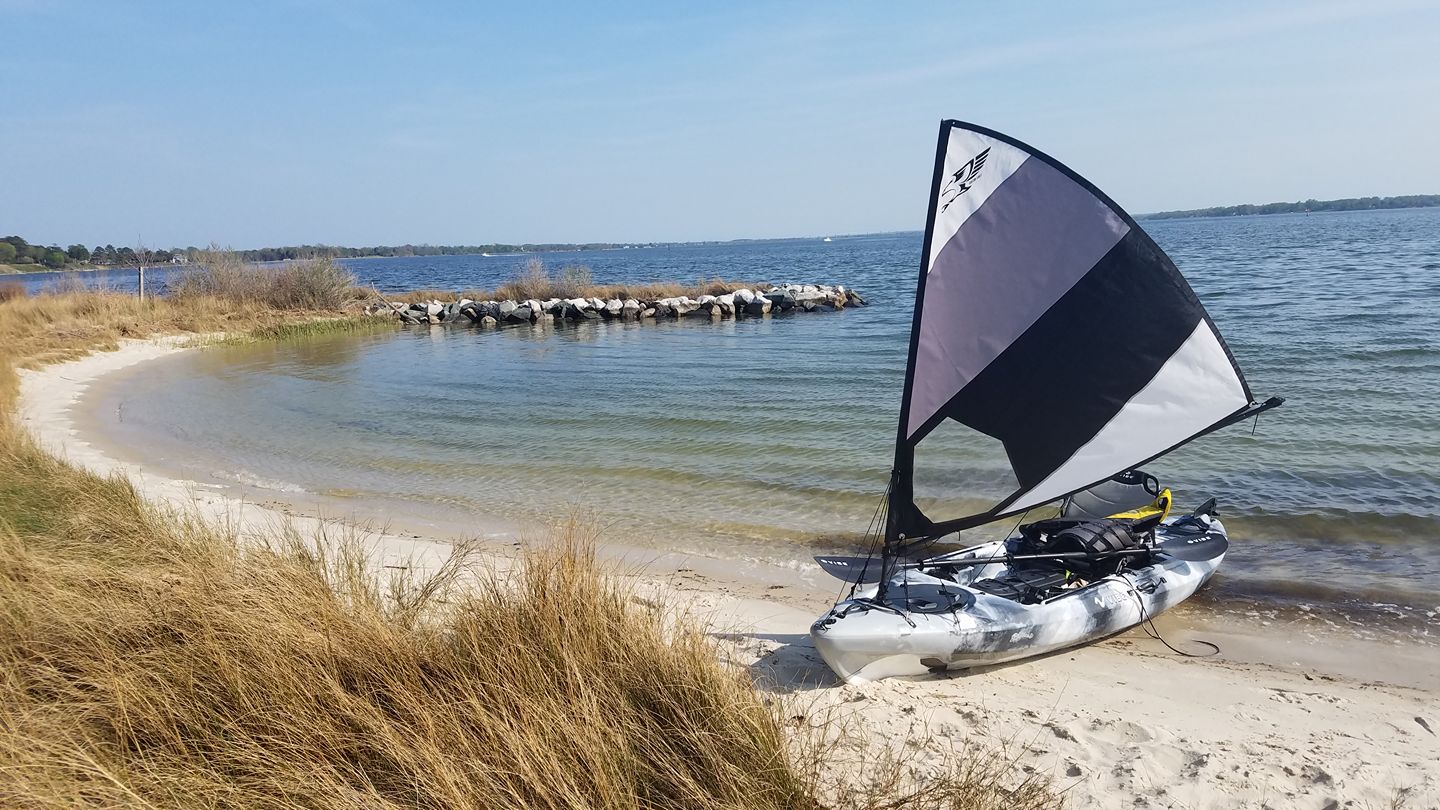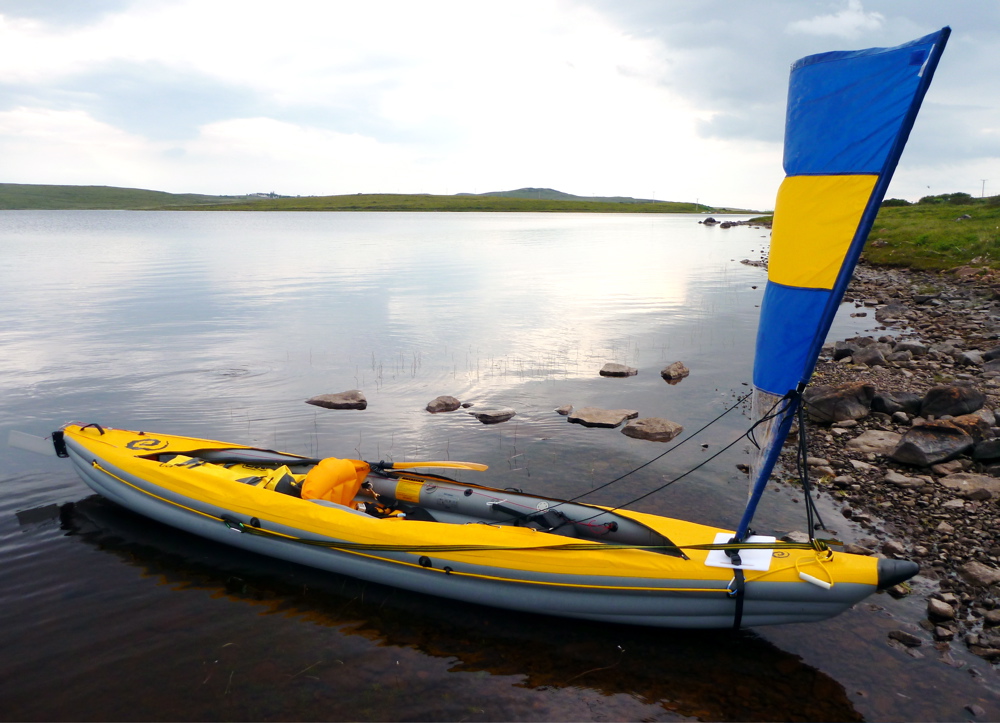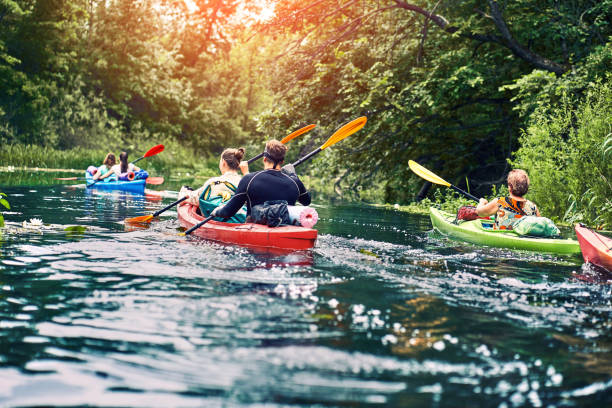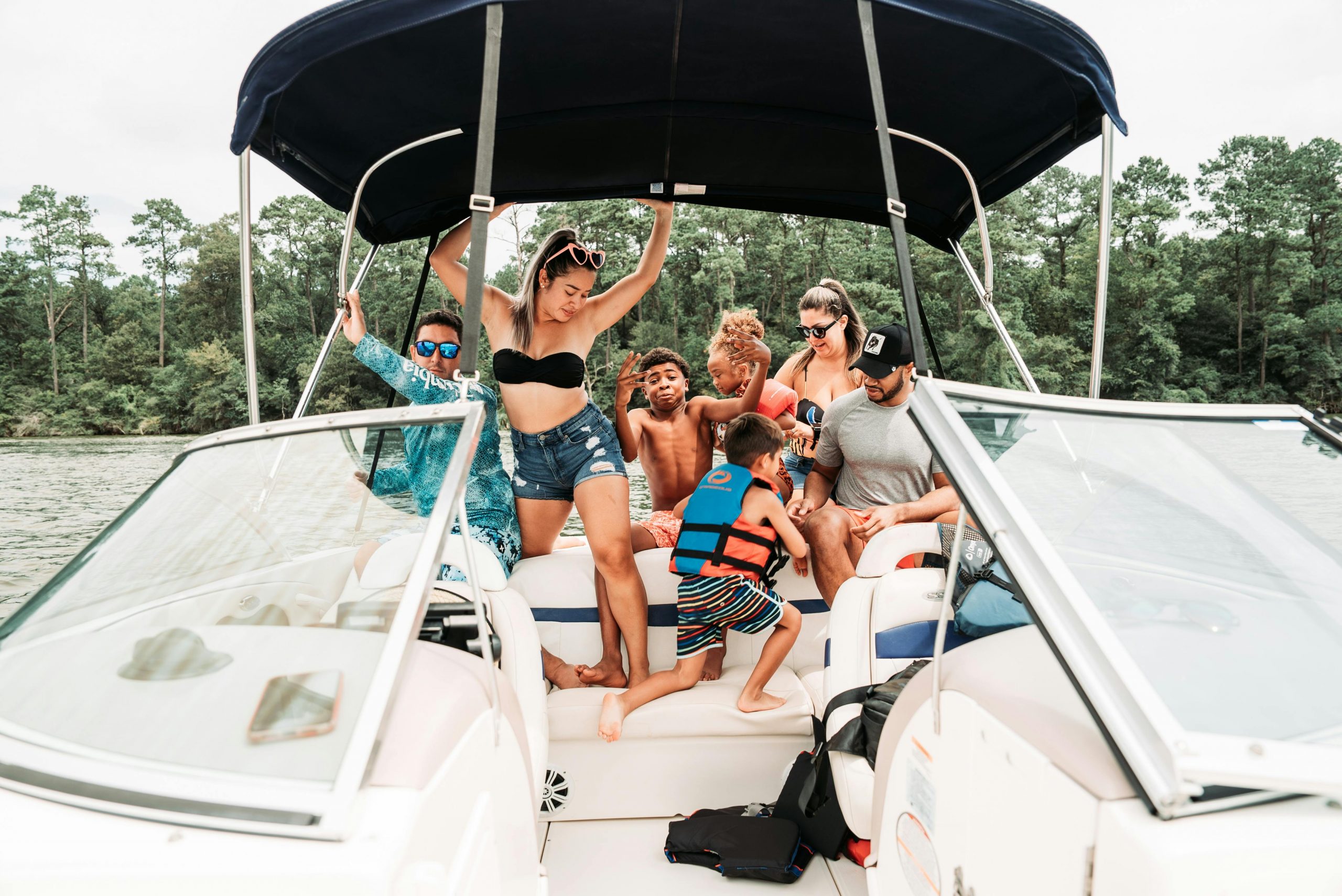Sailing Kayaks: A Complete Guide to Mastering the Waves
Sailing kayaks offer a unique and thrilling experience for water enthusiasts looking to combine the advantages of kayaking with the power of wind propulsion. With the proper equipment and techniques, sailing kayaks can improve your speed, stability, and efficiency on the water, opening up new possibilities for adventure and exploration. This guide aims to provide you with all the necessary information to help in your pursuit of kayak sailing, from selecting the right equipment to learning essential skills and sailing techniques.
There are several types of sailing kayaks available on the market, each with its own set of features and capabilities. Some are specifically designed for sailing, while others can be easily converted from traditional kayaks by adding rigging and sails. Understanding the essential components of a sailing kayak, such as the mast, sail, and rudder, is critical to maximizing performance and ensuring a safe and enjoyable experience on the water. Assembling and rigging your kayak sail can be a simple process with the right guidance and practice, which will be covered in this guide.

Key Takeaways
- Learn about different types of sailing kayaks and their features.
- Understand the components and rigging process for a kayak sail.
- Discover sailing techniques to enhance performance and maximize enjoyment.
Types of Sailing Kayaks
Sailing kayaks come in a variety of designs to suit different environments and personal preferences. This section will discuss some of the most common types of sailing kayaks, including recreational kayaks, sea kayaks, inflatable kayaks, sit-on-top kayaks, sit-in kayaks, and catamaran-style kayaks.
Recreational Kayaks
Recreational kayaks are designed for casual use in calm waters, such as lakes and slow-moving rivers. They are typically wide and stable, making them suitable for beginners and casual paddlers. These kayaks are not built for speed or long-distance sailing, but they are ideal for exploring local waterways and enjoying a leisurely day on the water.
Sea Kayaks
Sea kayaks are built for open water and long-distance sailing. They are designed with a longer and narrower hull, allowing them to cut through waves and maintain speed efficiently. These kayaks often have a rudder or skeg to assist in navigation and can accommodate additional gear for extended trips. Sea kayaks are well-suited for experienced paddlers seeking to explore coastal waters, bays, and open ocean environments.
Inflatable Kayaks
Inflatable kayaks are made of durable, puncture-resistant materials and can be easily inflated and deflated for transport and storage. These types of kayaks are highly portable, making them a popular choice for people with limited storage space or those who want to take their kayak on the go. While not as fast or as stable as hard-shell kayaks, inflatable kayaks still provide a good level of performance in various water conditions.
Sit-On-Top Kayaks
Sit-on-top kayaks have an open, user-friendly design that makes them ideal for beginners and recreational paddlers. With no enclosed cockpit, these kayaks provide easy entry and exit and eliminate the need for a spray skirt. Sit-on-top kayaks are self-draining, making them suitable for use in warm weather and various water conditions, including coastal waters, rivers, and lakes.
Sit-In Kayaks
Sit-in kayaks have an enclosed cockpit that provides better protection from the elements and improved control over the kayak. They are well-suited for cold water environments and longer sailing trips. Paddlers using sit-in kayaks will generally wear a spray skirt to keep water out of the cockpit and require a more refined technique for entering and exiting the kayak.
Catamaran-style Kayaks
Catamaran-style kayaks are unique in their design, featuring two parallel hulls connected by a platform or trampoline. This design provides exceptional stability and allows for the addition of a sailing rig, making them suitable for sailing as well as paddling. Catamaran-style kayaks can be used in a variety of water conditions, from calm lakes to open ocean environments.

Essential Kayak Sailing Components
Sailing kayaks have several key components that work together to ensure a smooth and enjoyable experience on the water. In this section, we will examine the essential components, including the sail, rudder, hull, outrigger, mast, and boom.
Sail
The sail is the primary means of propulsion for a sailing kayak. It's typically made of durable materials like Dacron or Mylar, designed to catch the wind and propel the kayak forward. The size of the sail affects the speed and handling of the kayak, with larger sails providing more power but potentially making the kayak more challenging to maneuver. There are various types of sails, including triangular Bermuda sails, furling sails, and even square sails, depending on the specific kayak design and intended use.
Rudder
The rudder is the steering mechanism for the sailing kayak, usually mounted on the stern of the boat. It's controlled by a tiller or foot-controlled pedals, allowing the kayaker to steer easily while maintaining balance. Proper rudder use is vital in controlling the kayak's direction, especially in strong winds or currents.
Hull
The hull is the body of the kayak, designed to provide buoyancy, stability, and maneuverability on the water. Hulls come in various shapes and materials, ranging from traditional hardshell designs made of fiberglass or rotomolded plastic to inflatable or folding hulls made of durable materials like PVC or Hypalon. The shape of the hull impacts how the kayak performs on the water, with V-shaped hulls provide better tracking and speed, while wide, flat hulls offer increased stability.
Outrigger
An outrigger is an optional stabilizing device for sailing kayaks, typically consisting of a long beam attached to the kayak with floats on the end. The main purpose of an outrigger is to increase stability and prevent capsizing, particularly when sailing in strong winds or rough water. Outriggers can be fixed or removable, with the latter allowing for increased versatility and ease of transport when not in use.
Mast
The mast is the vertical support for the sail, held in place by a combination of stays and shrouds. Masts come in various materials, from lightweight aluminum to sturdy carbon fiber, and heights, which affect the boat's handling and the amount of sail area available. Some sailing kayaks even have a collapsible or telescoping mast, making for easier transport and storage.
Boom
The boom is a horizontal support for the sail, running along the foot of the sail and attached to the mast. It helps maintain the shape of the sail, particularly when tacking or jibing, and can be adjusted to control sail tension and angle to the wind. Booms are commonly constructed of materials like aluminum or carbon fiber for durability and strength.
These six essential components collectively contribute to the performance, safety, and enjoyment of sailing kayaks. Understanding their functions and ensuring proper maintenance can enhance your experience on the water and help you make the most of your sailing kayak adventures.

Assembling and Rigging your Kayak Sail
When it comes to sailing kayaks, understanding how to correctly assemble and rig your kayak sail is essential for a smooth and enjoyable experience on the water. Following this guide, you will learn the basics of fitting the sail to your kayak and adjusting the rigging for optimal performance.
Fitting the Sail
Before you can begin sailing, you need to ensure that the sail is properly fitted to your kayak. You will most likely be using a kayak sail kit that includes all of the necessary components to attach the sail to your craft. Follow these steps to get started:
- Attach the mast base: Locate the secure mounting point on your kayak, usually found near the cockpit or the bow, where the mast base can be inserted and tightened down.
- Assemble the mast: If your sail kit came with a collapsible mast, follow the manufacturer's instructions and assemble the mast, ensuring that it is securely connected and extending to its full length.
- Position the sail: Unfurl the sail and slide it onto the mast, making sure that it is correctly oriented with any identification markings or logos facing up and visible.
- Attach the boom: Depending on the type of rigging system you have, this step may vary, but typically the boom will connect to the mast and then be secured to the bottom of the sail.
- Secure the sail: Finally, use the provided clips, ties, or bungee cords to secure the sail to your kayak, ensuring a snug fit that prevents the sail from becoming loose during sailing.
Adjusting the Rigging
After fitting the sail, it's essential to adjust the rigging to maximize performance and control while sailing. Proper rigging can significantly improve your sailing experience, giving you greater control over your kayak's movement and speed. Here are some tips for adjusting your kayak's rigging:
- Tighten the outhaul and downhaul: These two lines help control the sail's shape and tension. The outhaul runs across the bottom of the sail (from the mast to the outer edge), while the downhaul connects the bottom corner of the sail to the boom. Adjust these lines for optimal sail tension, considering wind conditions and your preferred sailing style.
- Adjust the sheet: The sheet is the primary line used for controlling the sail. A properly adjusted sheet allows for ease of control and smooth sailing performance. Experiment with different sheet lengths to find a balance that allows for quick adjustments without limiting your sail's flexibility.
- Set the center of effort: The center of effort is the point where the sail's force is balanced, which affects your kayak's stability and turning ability. Adjust the mast position or rigging lines to achieve the ideal center of effort, ensuring that the kayak remains stable and responsive while sailing.
- Assess the weather and water conditions: Make any necessary adjustments to the rigging based on the weather, wind direction, and water conditions. This might include tightening the sail in stronger winds or loosening it in lighter conditions to maximize performance and maintain control.
By following this guide on assembling and rigging your kayak sail, you can confidently and knowledgeably set out for a sailing adventure, achieving the best possible performance from your craft.

Kayak Sailing Techniques
Paddling Techniques
To ensure a successful kayak sailing experience, it is essential to master proper paddling techniques. Having a firm grip on the paddle and implementing efficient strokes will greatly enhance control and maneuverability. Focus on using your torso and core muscles while paddling rather than just your arms, as this will provide more strength and reduce fatigue.
Sailing Techniques
When transitioning from paddling to sailing, it's crucial to understand the basics of sail handling. Start by rigging the sail according to the manufacturer's instructions and familiarizing yourself with the equipment. Learn how to tighten and loosen the sail to adapt to various wind conditions. Additionally, practice efficient tacking, which involves changing the kayak's direction with the wind to maintain optimal sail angles.
Wind Awareness
Developing a keen awareness of the wind's direction and strength is key to successful kayak sailing. Pay attention to the telltales, such as fluttering flags or ripples on the water's surface, which indicate the wind's behavior. Continuously adjust your sail and body positioning to maintain control of the kayak in changing conditions.
Balancing Tips
Maintaining balance in a sailing kayak requires proper weight distribution and body positioning. To prevent capsizing, lean into the wind, and use your paddle as an outrigger when necessary. Adjusting your seating position can also help maintain stability. For instance, moving forward in lighter winds and backward in heavier winds can have a significant impact on the kayak's balance.
Upwind Sailing
Upwind sailing, also known as beating or sailing close-hauled, is a technique where the kayak sails at an angle towards the wind. This method requires skill and precision to maintain both balance and speed. To sail upwind, position your kayak at a 45-degree angle to the wind and keep the sail tight. Continuously fine-tune your course and sail settings to maximize efficiency and maintain control.
By incorporating these fundamental kayak sailing techniques, you'll be well-prepared for a successful and enjoyable sailing experience.

Kayak Sails and Accessories
Different Types of Kayak Sails
There are various types of kayak sails available in the market, each offering unique benefits to enhance the sailing experience. The most common types of sails include the V-shape sail, the circular sail, and the flat sail. The V-shape sail is known for its excellent upwind performance, while the circular sail provides better downwind sailing. The flat sail is versatile and suitable for various wind conditions.
When choosing a sail, consider factors like ease of setup, compatibility with your kayak, and intended use. Several high-quality brands offer durable kayak sails made from resilient materials to ensure long-lasting performance.
Paddles and Rudders
A good quality paddle is essential for propelling and maneuvering your kayak. The best paddles are made of lightweight materials such as carbon fiber or fiberglass, which offer a perfect balance between weight and strength.
Rudders are another crucial accessory that improves kayak stability, especially when sailing in rough waters or strong winds. They also help in steering and tracking the kayak. When selecting a rudder, consider its compatibility with your kayak, the quality of construction, and ease of installation.
Additional Accessories
Apart from sails, paddles, and rudders, there are other valuable accessories that can enhance your overall kayaking experience:
- Spray skirts: They protect the cockpit from water splashes and help to maintain a dry environment inside the kayak.
- Life jackets: Investing in a quality life jacket is of utmost importance as it ensures safety while sailing.
- Dry bags: These bags are essential for keeping your belongings dry while sailing. They come in various sizes and materials, making them useful for storing items like phones, clothes, and cameras.
- Bilge pumps: A hand-operated bilge pump is a vital tool for preventing water buildup inside the kayak.
- Navigation tools: Equip yourself with essential navigation tools like a compass, map, and GPS device, to avoid getting lost while exploring open waters.
Remember, investing in quality and durable accessories will provide you with a safer and more enjoyable kayaking experience. Always consider your individual needs and preferences to find the best kayak sails and accessories for your unique adventure.

Kayak Sailing Performance
Speed and Efficiency
When it comes to kayak sailing performance, speed and efficiency play a crucial role. The speed of a sailing kayak is largely influenced by its length, width, and weight capacity. Generally, a longer kayak will have a higher potential for speed due to its increased waterline length, which reduces drag and allows for more efficient water displacement. However, it is essential to find a balance between length and stability, as a too-long kayak may be challenging to maneuver.
The width of a sailing kayak also affects its speed. A narrow kayak will typically be faster, as it creates less drag and allows for smoother water flow. On the other hand, a wider kayak provides more stability, which is essential for maintaining balance while sailing. The weight capacity of a sailing kayak is another critical factor that can impact its performance. Lighter kayaks will generally be more efficient due to their reduced weight, which allows them to glide more easily through the water.
Determining the Right Size
To determine the optimal size of a sailing kayak for your needs, consider the following factors:
- Length: As mentioned earlier, longer kayaks generally have faster performance. However, keep in mind that longer kayaks can be more challenging to maneuver in tight spaces. For beginners, a mid-length kayak, ranging from 12 to 15 feet, may provide a good balance between speed and maneuverability.
- Width: A wider kayak offers overall stability and is recommended for beginners or those who plan to sail in rough water conditions. However, it may be slower compared to a narrow kayak. When deciding on the right width, consider your experience level and the type of water conditions you plan to sail in.
- Weight Capacity: Ensure that the sailing kayak you choose can comfortably accommodate your weight and any additional gear you plan to bring along. Additional weight can significantly affect the kayak's performance, so be mindful not to overload it.
By taking into account these factors, you can select a sailing kayak that best suits your needs and skill level, ensuring a safe and enjoyable experience on the water.

Sailing Kayaks for Fishing and Adventure
Sailing kayaks have grown in popularity due to their versatility, offering unforgettable experiences on the water, both for fishing and adventure. They provide a budget-friendly option for those looking to enjoy summer excursions. This section will discuss the unique fishing and adventure opportunities that sailing kayaks offer.
Fishing Experiences
Sailing kayaks allow anglers to access hard-to-reach fishing spots, which can make for a more exciting and successful fishing experience. With their shallow draft and nimble maneuverability, kayaks can effortlessly glide into narrow, shallow areas, providing access to unpressured fish populations. Moreover, the quiet nature of kayak fishing allows anglers to sneak up on fish without spooking them, increasing the chances of a productive catch.
When it comes to fishing, sailing kayaks offer several advantages:
- Stealth: The absence of a loud motor allows for sneakier approaches, increasing catch rates
- Portability: Lightweight and easily transportable, enabling hassle-free, spontaneous fishing trips
- Customization: Many kayaks are equipped with gear tracks and mounts, perfect for adding fishing accessories
Adventure Exploration
Adventure enthusiasts seek out new experiences, and sailing kayaks can open up a world of exploration opportunities. Kayaking provides a unique way to experience nature up-close, with the ability to paddle into secluded coves, navigate winding streams, or sail across open water. The inherent versatility of a sailing kayak means that it can be easily adapted to different environments and conditions, making it an ideal vessel for adventurers.
Sailing kayaks offer several benefits for adventure seekers:
- Eco-friendly: Sail power produces no emissions, making it an environmentally-friendly choice for exploration
- Exercise: Paddling or pedaling kayaks offer an excellent full-body workout
- Tranquility: The peaceful and serene nature of kayaking enables a deeper connection with the surroundings and wildlife
In conclusion, sailing kayaks are a fantastic option for those seeking budget-friendly fishing and adventure experiences during the summer months. Their versatility, portability, and low environmental impact make them an attractive choice for a wide range of outdoor enthusiasts.

Choosing the Right Sailing Kayak
When looking for the perfect sailing kayak, comfort and functionality should be at the forefront of your decision-making process. Sailing kayaks are specifically designed to provide a stable and enjoyable experience, allowing you to explore the water without any hindrance. There are various types to choose from, including sailboats, inflatable kayaks, and catamarans.
For beginners, it's essential to consider a vessel that offers stability, ease of use, and a manageable deck size. In this context, a Hobie sailing kayak can be an excellent option. These kayaks are known for their user-friendly designs and are particularly suitable for novices.
When it comes to vessel composition, inflatable sailing kayaks offer the advantage of portability and easy storage. These kayaks can be deflated when not in use, allowing you to transport and store them with minimal effort. However, their durability might be slightly compromised compared to their solid counterparts.
Decks play a crucial role in the functionality of sailing kayaks. A spacious and well-designed deck provides space for efficient sail handling, reduces flapping, and ensures a comfortable sailing experience. Some kayaks even have storage compartments to keep your belongings safe and dry.
Sailboat-style kayaks, such as catamarans, offer greater speed and agility on the water. These boats have two parallel hulls, which provide increased stability and performance. They are suitable for more experienced sailors or individuals who enjoy a faster pace while sailing.
Ultimately, choosing the right sailing kayak depends on your skill level, intended use, and personal preferences. It is essential to select a kayak that provides comfort and meets your unique sailing requirements. Spend time researching different types of kayaks, such as canoe and kayak handbooks, to make an informed decision that will benefit your sailing adventures.

Frequently Asked Questions
What are the best kayaks for sailing?
There is a variety of kayaks suitable for sailing depending on personal preferences, skill level, and intended use. Some of the top kayaking brands include Hobie, Advanced Elements, and Ocean Kayak. It is important to consider factors such as weight capacity, stability, and the intended type of water conditions when choosing a kayak for sailing. Research the specific models that fit your needs and make sure to test them on the water before making a final decision.
How do kayak sails function?
Kayak sails generally function by harnessing the wind power to propel the kayak forward. They are usually mounted on the front or center of the kayak and are connected to a mast. The user can control the sail angle and direction by adjusting the lines attached to the sail, known as "sheets." This helps manage the amount of wind caught by the sail and, therefore, the speed and direction of the kayak. The kayaker can also use a rudder or paddle to help steer the kayak in the desired direction.
Can windsurf sails be used on kayaks?
Although it might be possible to modify a windsurf sail to fit a kayak, it is generally not recommended. Windsurf sails are designed differently and may not provide the desired stability, control, and efficiency required for a kayak. Instead, it is best to use sails specifically designed for kayaks, as they offer better stability, performance, and ease of use. There are several kayak sail options available designed to cater to various skill levels and kayak types.
How to add a sail to a kayak?
To add a sail to your kayak, first, choose a sail kit that is compatible with your specific kayak model. Generally, these kits come with all necessary components, including the sail, mast, rigging, and attachment hardware. Follow the manufacturer's instructions carefully to install and rig the sail correctly. Be sure to practice using the sail in a controlled environment before venturing into open waters, as it takes some experience to sail a kayak properly.
Are kayak sails a worthy investment?
Sails can significantly expand the functionality and enjoyment of a kayak by allowing you to harness wind power. They offer a more relaxed paddling experience by reducing fatigue and enabling long-distance exploration. Kayak sails also provide an added level of versatility, as they can be used in various conditions: from calm, leisurely paddling to thrilling downwind runs. If you enjoy kayaking and want to extend your adventures on the water, a kayak sail can be a worthy investment.
Do sailing kayaks capsize easily?
While the possibility of capsizing always exists in any watercraft, sailing kayaks are generally designed to be stable. The combination of the kayak's hull design, the position of the sail, and the user's skill and experience will affect the kayak's stability while sailing. It is essential to choose a kayak suitable for the intended conditions and to practice proper sailing techniques to reduce the risk of capsizing. Additionally, always wear appropriate safety gear such as a life jacket and be prepared with a plan in case of a capsize.
Q&A With Sales Rep From Hobie
Charlie (C): Good afternoon and welcome to Sea Magazine's exclusive interview! I'm your host, Charlie, the Editor of Sea Magazine, and today we are joined by Alex, a sales representative from the esteemed Hobie Cat. How are you, Alex?
Alex (A): I'm doing great, Charlie, thanks for having me.
C: Fantastic! Let's dive right in. I know our audience is excited to hear more about Hobie Cat's products. Can you tell us more about the Kobe kayak sail kit that is trending in the falcon kayak sales?
A: Absolutely, Charlie. The Kobe kayak sail kit is one of our best selling products currently. It's primarily designed to improve the kayak's performance in both upwind and downwind conditions. The kit includes a carbon fiber mast, which is both lightweight and robust, offering optimum support for the sail.
C: That sounds quite interesting. So how does this set Hobie Cat apart from other kayaks?
A: That's a good question, Charlie. I think the difference lies in the attention to detail that Hobie Cat puts into every product. For example, the Kobe kit includes an I shaped sail that provides more wind surface area. This allows our kayak sailors to harness more wind, enhancing their speed and control over their kayak.
C: Fascinating! And I understand you also have a V shaped sail. How does that compare with the I shaped sails?
A: Yes, you're correct. The V shaped sail is generally used when we want to decrease the surface area in response to stronger wind conditions. This way, the paddler can maintain control and stability even in challenging conditions.
C: Interesting! Now, let's shift gears a little. Can you tell us about the circular kayak sales and how they fit into Hobie Cat's product line?
A: Sure, Charlie. By circular kayak sales, we refer to our unique business model at Hobie Cat, which we like to call "circular sales". It includes providing complete guidance and assistance to our customers before, during, and after the sale of our kayaks. Our focus is not just on the initial sale, but also on providing excellent after-sale services to ensure that our customers have the best possible sailing experience.
C: That's truly impressive! Speaking of best experiences, what's the best kayak sale you've had so far this year?
A: The best kayak sale this year would be the Falcon sails. These sails are designed with carbon fiber masts, making them lighter and more efficient. Plus, the unique design ensures great performance even in upwind conditions.
C: That's wonderful! Now, let's get a bit practical. Could you give our audience a tip on how to handle the Hobie kayak sweepstroke?
A: Of course, Charlie. The sweepstroke is an essential maneuver in kayaking, it helps to change the direction of the kayak without moving it forward or backward. I would recommend our viewers to watch our YouTube tutorial for a comprehensive guide.
C: That sounds like a great resource. Just one last question - how does a kayak compare with a canoe, especially when considering heading to the shore in still waters?
A: That's an excellent question, Charlie. In still water conditions, both canoes and kayaks can be easy to navigate. However, a kayak typically sits lower in the water, reducing wind resistance, and its streamlined hull provides an edge in terms of speed. This means, heading back to shore could be faster in a kayak, depending on the paddler's experience.
C: Alright, Alex, let's continue our discussion. I understand that Hobie Cat also offers an 'eye' shaped sail. Could you tell us how this differs from the I and V shaped sails?
A: Sure, Charlie. The eye shaped sails, like the I and V shaped sails, are designed to provide optimal performance in various wind conditions. The eye shaped sail has a wider middle area and tapers towards the top, which can capture more breeze and improve downwind performance.
C: Sounds like an interesting design. I'm sure our kayak sailors will be keen to try it out. Now, regarding the Hobie kayak sail kit, is there a particular way to stow the sail when it's not in use?
A: Absolutely, Charlie. The Hobie kayak sail kit comes with an easy stowing method. You can easily roll up the sail around the mast, secure it with the provided rope, and then it can be stored in a minimal space. This makes it very convenient for our kayak sailors, especially when they're out on the water and need to quickly pack away the sail.
C: That's very convenient indeed. Switching the topic a little, can you tell us about the kayak hull and how it contributes to the overall sailing experience?
A: Yes, the kayak hull is a critical part of the sailing experience. Our Hobie Cat kayaks have a specially designed hull that enhances stability and maneuverability. This design allows for smooth movement through the water, making it easier to manage even in stronger wind conditions.
C: Amazing! Now, let's touch upon the sweet stroke. What's unique about it, and how does it enhance the kayaking experience?
A: The sweet stroke is another key paddling technique. It's all about timing and the right application of force to achieve a smooth and efficient stroke. It requires a bit of practice to master but once you get it right, it can significantly improve your paddling efficiency. We have a video tutorial on this on our YouTube channel, which I highly recommend to our customers.
C: Fantastic! Finally, could you tell us about the Falcon kayak sales? How are they doing and why are they the best kayak sale for Hobie Cat?
A: The Falcon kayak sales have been phenomenal. The Falcon series is popular for its outstanding performance in various sailing conditions, thanks to the high-quality downwind sail and the sturdy carbon fiber mast. Our circular sales strategy, which focuses on customer support before, during, and after the sale, has also contributed to its success. The Falcon kayak is truly our best kayak sale, and we are proud to offer this product to our customers.
C: Let's carry on with our fascinating conversation, Alex. Could you shed some light on the role of outriggers in Hobie's kayak sailing kit?
A: Sure, Charlie. Outriggers are essentially stabilizing structures that can be added to a kayak for added stability and durability. They're especially useful in rougher water conditions, as they help the kayak maintain balance and prevent capsizing.
C: That certainly sounds like an essential piece of gear for any serious kayaker. Moving on, how does the I shaped sail affect the direction of the kayak relative to the wind?
A: That's an interesting question, Charlie. The I shaped sail is designed to catch the wind effectively and provide maximum propulsion. The shape allows for better control over the kayak's heading, even in changing wind directions. The sailor can adjust the angle of the sail to the wind direction to ensure optimal performance.
C: Fantastic! That seems like a game changer for our avid kayak sailors. Now, can you talk about the circular sales model at Hobie Cat? How does it contribute to the successful Falcon kayak sales?
A: Sure, Charlie. Our circular sales model revolves around customer satisfaction at every stage of the buying process. It begins with guiding the customer to choose the right product, such as the Falcon kayak, based on their specific needs and preferences. After the sale, we continue to support them by providing information on kayak sailing techniques, maintenance tips, and other valuable resources.
C: So, it's more than just a product sale for Hobie Cat. You're selling an experience, and you follow through with customer support. It's certainly a model other businesses could learn from.
A: Absolutely, Charlie. At Hobie Cat, we believe that the customer's journey doesn't end with the sale. The post-sale area is just as important, and we are committed to ensuring that our customers are fully satisfied with their purchase.
C: Well, that certainly shows in your best selling products. Speaking of which, could you talk more about the sweepstroke and how a paddler can practice it?
A: Definitely, Charlie. The sweepstroke is an important technique in kayak sailing that allows the paddler to turn the kayak without losing momentum. It's a wide, sweeping stroke that requires the paddler to push the paddle blade in a wide arc from the bow to the stern on one side of the kayak. To practice, I recommend our customers watch our video tutorial and then try to replicate the movement on calm waters.
C: Great! I'm sure our readers will appreciate the practical advice. Lastly, how does Hobie Cat ensure the durability of its kayaks and sails?
A: Durability is a key factor for us at Hobie Cat. We only use high-quality materials in our products. Our kayak hulls are made of durable, lightweight materials that can withstand the rigors of sailing. As for our sails, we use robust materials that can handle various wind conditions, ensuring a long lifespan for our products.
C: That's reassuring for any potential buyers out there. Thank you so much for your time, Alex, and for sharing these insights about Hobie Cat and your products. We've certainly learned a lot today!
A: My pleasure, Charlie. It was great discussing these topics with you. Looking forward to our next conversation!
Charlie is Editor-in-Chief of Sea Magazine







